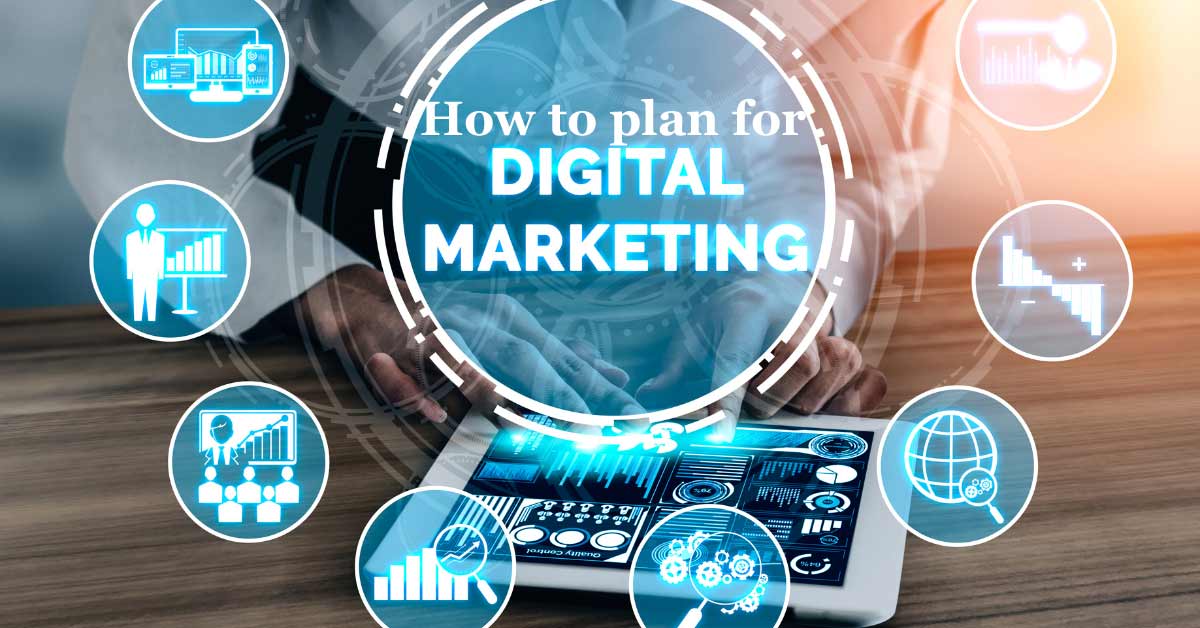How to Plan for Digital Marketing
Introduction
Planning for digital marketing is crucial for any business looking to grow and succeed online. With the rise of social media, mobile devices, and other technologies, customers are spending more and more time online. Businesses need an effective digital marketing strategy to connect with target audiences and promote their brand where their customers are. Proper planning and preparation can help ensure your digital marketing efforts are successful. Let’s look at some key steps for how to plan for digital marketing.
Set Your Goals
The first step is to establish your goals. What do you want to achieve from your digital marketing? Common goals include increasing website traffic, generating more leads, boosting brand awareness, and driving online sales. Setting SMART goals will help provide focus and give you benchmarks to track progress. Outline the metrics you’ll use to determine success. With clear goals in place, you can craft a strategy to meet them.
Do Market Research
Before defining your digital marketing strategy, it’s vital to understand your target audience and the digital landscape. Conduct thorough market research to gain key consumer insights. Learn about your ideal customer demographics, behaviors, needs, and interests. Identify where they are spending time online, which social platforms they use, and what kind of content resonates. Research your competitors to analyze what digital marketing tactics they are using and how you can differentiate. Ongoing market research ensures your plan stays relevant.
Choose Your Platforms
With research completed, you can determine which digital platforms make the most sense for your brand. Key options include your website, content marketing, email marketing, social media, SEO, and paid advertising. Evaluate each platform based on your products, target audience, content format, and budget. While it’s good to diversify, it’s better to focus on just a few channels and do them well. Then you have to choose the platforms that align with your goals and audience.
Develop Content Strategy
Content is the fuel for digital marketing success. Your content should educate, entertain, or inspire your audience to support your goals. Identify what types of content (blog posts, videos, infographics, eBooks, etc.) will best resonate with your customers. Plan out a monthly content production schedule to maintain consistency. Optimize content for SEO keywords to improve search visibility. Share content across your digital platforms to maximize reach. Measure content performance and refine your approach over time.

Define Your Branding
Customers engage with brands they know, like, and trust. That makes branding critical for digital marketing. Define your brand identity and messaging. Convey your brand consistently across websites, social media bios, graphics, videos, and ads. Utilize brand elements like color schemes, fonts, and logos to boost recognition. Branded content and personalized interactions can help build relationships with your audience. Developing a strong, consistent brand will increase engagement.
Set Up Conversion Paths
While traffic and followers are nice, conversions ultimately determine ROI. A conversion path is a strategic journey to guide visitors from discovery to becoming customers. This may move them from social media ads to landing pages to email nurturing. The key is structuring your digital assets and campaigns to optimize conversion potential. Remove friction and encourage users to take desired actions like signing up, checking out, or scheduling a call. Test different pathways to see what converts best.
Implement Analytics
Any good digital marketing plan must incorporate analytics to measure performance. Key metrics include website visits, leads generated, sales completed, engagement rates, click-through rates, and ROI. Establish analytics and tracking for your website, ads, email, and social media. Regularly monitor dashboards and reports to identify successes and areas needing optimization. Data insights allow you to refine your approach to improve conversion rates over time.
Optimize With Testing
One strategy will not work forever. You need to continually test and optimize your digital marketing plan. Try different messages, content formats, platforms, keywords, promos, calls to action, and more. A/B split testing can systematically determine what resonates best with your audience. Take lessons from the data to double down on what works and pivot away from what doesn’t. Agile optimization is key to maximizing your digital marketing ROI.
Integrate Efforts
The most effective digital marketing strategies have integrated campaigns across channels. Email marketing might prompt a social media post which links to a landing page. Or social ads can drive traffic to your blog. Create a unified workflow to align your efforts. Consistent messaging and branding maintain credibility. Automation and scheduling tools can help streamline implementation across platforms. With integrated digital marketing, the total impact is greater than the sum of its parts.
Maintain Agility
In the fast-paced digital landscape, marketing plans must remain agile. As technology, trends, and consumer behavior evolve, strategies that worked yesterday may falter tomorrow. Stay on top of developments in the digital space and keep testing new tactics. Be prepared to shift gears if needed to stay relevant. While foundational goals and branding may stay constant, remain flexible in how you execute campaigns. An agile approach positions you for continued digital marketing success.
Conclusion
Planning is paramount when it comes to creating an effective digital marketing strategy. As we have explored, there are many key steps involved in developing a robust digital marketing plan. First, you must clearly define your goals and conduct thorough market research to understand your target audience and competitive landscape. Once you have a solid grasp of who you are targeting and where they spend their time online, you can strategically choose digital platforms that align with your goals and audience.
A core component of any digital marketing plan is branded content strategy. Your content should engage and resonate with your customers to support your goals. Optimization of conversion paths from discovery to conversion is also crucial to maximize ROI. Implementing analytics allows you to measure performance and optimize based on data insights. A successful digital marketing strategy requires integrated campaigns across channels with consistent messaging and branding.
As summarized, developing a robust plan is essential to unlock the potential of digital marketing. By setting goals, researching your audience and competitors, selecting platforms, creating branded content, optimizing conversion paths, utilizing analytics, testing continuously, integrating cross-channel efforts, and maintaining agility, you can craft a high-impact digital marketing strategy. With clear planning and effective execution, you will connect with customers, boost engagement, and achieve online business growth. Digital marketing success requires commitment and effort, but following these planning steps will get you off to a strong start. Now is the time to lay the foundation for your digital marketing roadmap and propel your brand forward online. To add AI at your Marketing Strategy, read this article.

